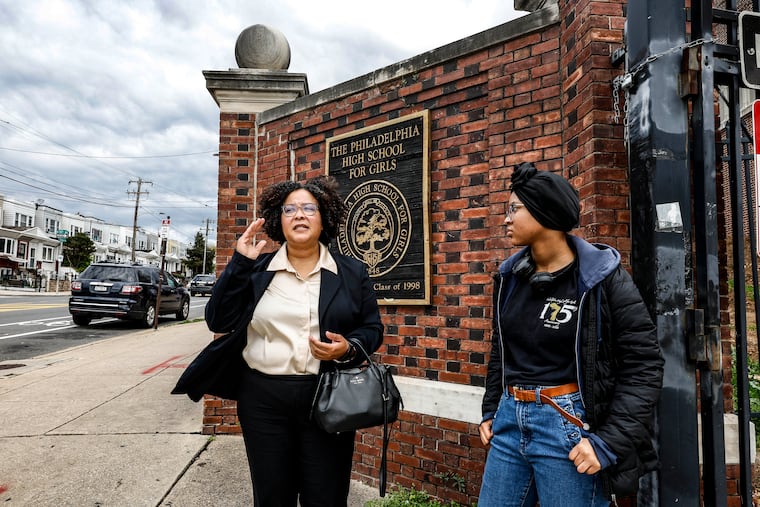Girls’ High advocates successfully fought cuts at the school. Now what happens?
Efforts to stop staff reductions at the 176-year-old magnet school appear to be paying off.

After a public outcry from students, parents, and alumnae, the Philadelphia School District has reversed planned teacher cuts at the Philadelphia High School for Girls.
Due to declining enrollment, Girls’ High, a 176-year-old city magnet school, had stood to lose several teachers — including those who run popular school programs, teach Advanced Placement, International Baccalaureate, science and art classes — and a climate manager.
“We were able to get things turned around,” said Deanda Wilson, parent of a Girls’ High junior and president of the school’s Parent Teacher Daughter Association. When the extensive teacher cuts were planned, Wilson and others feared the long-term viability of the school.
“Girls’ High is viable! No positions are being eliminated,” Monique Braxton, a district spokesperson, said in a statement.
But Wilson warned there’s more work to do: “It’s so easy to say, ‘Oh, they’ve got their teachers back, end of story.’
“But it’s a lot more than that.”
The backstory
The school at Broad and Olney has endured a challenging stretch: the pandemic, then unwanted attention after a student’s diploma was temporarily withheld because she danced across the stage at graduation. The school’s principal was removed soon after.
Then, Girls’ was one of a number of smaller Philadelphia magnet high schools that had significant enrollment drops — this year’s ninth-grade class was just 88 students, down from 200 the prior year — due to changes in the district’s special admissions policy. (The 2021 policy, created as a way to ensure the city’s demographics were reflected in its 39 criteria-based and citywide admissions schools, takes agency from school principals to make admissions decisions and leaves it to a lottery.)
This year, there was fear over asbestos repairs that were not well communicated with students and families. Then, a Girls’ High teacher was charged with attempting to sexually abuse a 16-year-old student. The school still lacks a permanent principal, and the Girls’ community had concerns about a lack of transparency around that process.
Saniyah Brown, the Girls’ High junior class president, took her concerns to the school board in April. Beyond the specter of losing teachers, Brown said, the school needs much more, like physical upgrades and a functioning school library.
“We deserve the effort and funding from the school district to make sure that Girls’ High stays an academically excellent school,” Brown said. “I’m fighting for this effort now because I don’t want my little sisters to struggle with the same troubles I’ve had.”
A City Council ally
City Councilmember Katherine Gilmore Richardson, a 2001 graduate of the school, credits the district with responding to community concerns and improving communications since the concerted push for Girls’ began — pressure that resulted in 300 alumnae, parents and students attending a recent town hall meeting to discuss how the school can move forward.
And Gilmore Richardson, who spends one day a month at the school, is pleased that the district has pledged to include community voices in the principal selection process.
But the work is ongoing, said Gilmore Richardson.
“We need to overall invest in Girls’ High, and we need three to five years to work through the challenges we know we face,” the council member said.
Gilmore Richardson has also publicly raised her continued concerns about the district’s special admissions process to Superintendent Tony B. Watlington Sr. and other district officials.
“The special admissions policy has not been helpful for Girls’ High at all,” said Gilmore Richardson. “We want the new, permanent principal to have some autonomy over the process in some kind of way.”
‘More necessary now’
Wilson, the PTDA president, was cautiously optimistic at that packed town hall, where district officials pledged help with developing a sustainability plan for Girls’, including help with outreach to market its unique strengths.
“The next step is to start to rebuild our reputation, to try to figure out how to let everyone know what Girls’ High has to offer, that we’re rebuilding,” said Wilson. “Amazing young women are graduating from this school every year, and it’s not being talked about. We’ve been neglected, frankly, and we’re fighting to get back on our feet and get the support we need and we deserve.”
But, Wilson said, it’s crucial that the work is long-term. Girls’ will need experts to help it craft the path forward, and Wilson is looking for professionals to help with the strategic work of rebuilding and shoring up the school’s foundation.
It’s never mattered more, said Wilson.
“This is a time where our citizenship, our very autonomy is being called into question — are women even full citizens in this country? Girls’ High is probably more necessary now than any time its history,” she said. “We need to have a school where women are trained to be leaders and shown where their opinions, their voices matter.”
Rowan Arthur, another Girls’ High junior who advocated for her school at the April school board meeting, agrees.
“I would love,” Arthur said, “to have more students be able to experience the joy and excitement that come with the longstanding traditions of our school.”